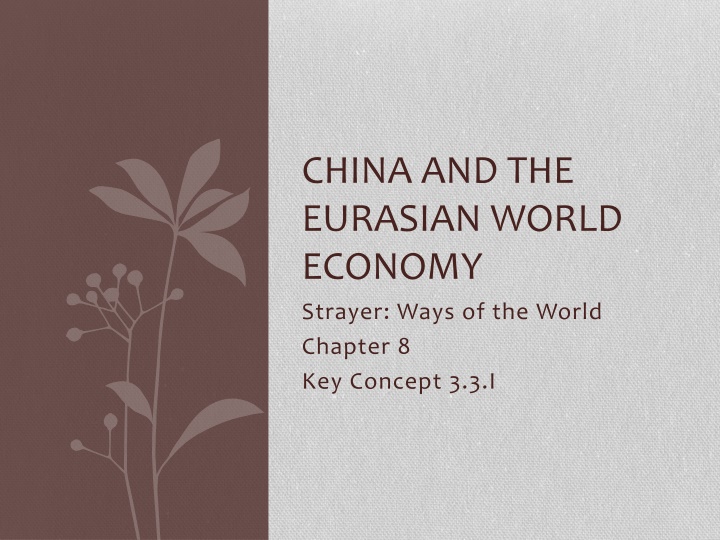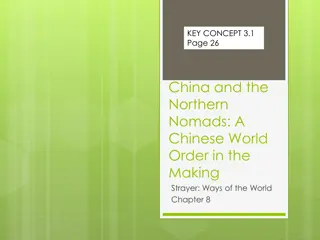China's Influence on Eurasia
China's impact on Eurasia through technological innovations, economic benefits, and the spread of Buddhism. Discover how Chinese advancements shaped the Eurasian world economy and cultural landscape.
Download Presentation

Please find below an Image/Link to download the presentation.
The content on the website is provided AS IS for your information and personal use only. It may not be sold, licensed, or shared on other websites without obtaining consent from the author.If you encounter any issues during the download, it is possible that the publisher has removed the file from their server.
You are allowed to download the files provided on this website for personal or commercial use, subject to the condition that they are used lawfully. All files are the property of their respective owners.
The content on the website is provided AS IS for your information and personal use only. It may not be sold, licensed, or shared on other websites without obtaining consent from the author.
E N D
Presentation Transcript
CHINA AND THE EURASIAN WORLD ECONOMY Strayer: Ways of the World Chapter 8 Key Concept 3.3.I
Spillovers: China s Impact on Eurasia many of China s technological innovations spread beyond its borders salt production through solar evaporation papermaking printing (though resisted by the Islamic world) gunpowder invented ca. 1000, but used differently after it reached Europe Chinese textile, metallurgical, and naval technologies also stimulated imitation and innovation (e.g., magnetic compass) Chinese prosperity stimulated commercial life all over Eurasia
On the Receiving End: China as Economic Beneficiary China learned cotton and sugar cultivation and processing from India China was transformed around 1000 by introduction of new rice strains from Vietnam technological creativity was spurred by cross-cultural contact growing participation in Indian Ocean trade foreign merchant settlements in southern Chinese ports by Tang era sometimes brought violence, e.g., massive massacre of foreigners in Canton in the 870s transformation of southern China to production for export instead of subsistence
CHINA AND BUDDHISM Strayer: Ways of the World Chapter 8 Key Concept 3.3.III
Buddhism was Indias most important gift to China China s only large-scale cultural borrowing until Marxism China was the base for Buddhism s spread to Korea and Japan
Making Buddhism Chinese Buddhism entered China via Silk Roads in first second centuries C.E. had little appeal at first Indian culture was too different from Chinese Buddhism took root 300 800 C.E. collapse of the Han dynasty ca. 200 C.E. brought chaos and discrediting of Confucianism nomadic rulers in northern China favored Buddhism Buddhism was comforting monasteries provided increasing array of social services Buddhists appeared to have access to magical powers serious effort to present Buddhism in a form accessible to the Chinese it was Mahayana form of Buddhism that became popular Sui and early Tang dynasties gave state support to Buddhism Sui emperor Wendi (r. 581 604) had monasteries built at base of China s five sacred mountains monasteries became very wealthy Buddhism was never independent from state authorities
Losing State Support: The Crisis of Chinese Buddhism growth of Chinese Buddhism provoked resistance and criticism deepening resentment of the Buddhist establishment s wealth it was foreign and thus offensive monastic celibacy and withdrawal undermined the Confucian-based family system new xenophobia perhaps started with An Lushan rebellion (755 763), led by foreign general Chinese state began direct action against foreign religions in 841 845 260,000 monks and nuns forced to return to secular life thousands of monasteries, temples, and shrines confiscated or destroyed Buddhists forbidden to use precious metals or gems for their images Buddhism did not vanish from China ; it remained an important element of popular religion























